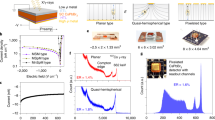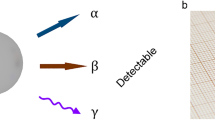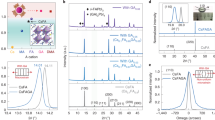Abstract
Organic–inorganic halide perovskites (OIHPs) bring an unprecedented opportunity for radiation detection with their defect-tolerance nature, large mobility–lifetime product, and simple crystal growth from solution. Here we report a dopant compensation in alloyed OIHP single crystals to overcome limitations of device noise and charge collection, enabling γ-ray spectrum collection at room temperature. CH3NH3PbBr3 and CH3NH3PbCl3 are found to be p-type and n-type doped, respectively, whereas dopant-compensated CH3NH3PbBr2.94Cl0.06 alloy has over tenfold improved bulk resistivity of 3.6 × 109 Ω cm. Alloying also increases the hole mobility to 560 cm2 V−1 s−1, yielding a high mobility–lifetime product of 1.8 × 10−2 cm2 V−1. The use of a guard ring electrode in the detector reduces the crystal surface leakage current and device dark current. A distinguishable 137Cs energy spectrum with comparable or better resolution than standard scintillator detectors is collected under a small electric field of 1.8 V mm−1 at room temperature.
This is a preview of subscription content, access via your institution
Access options
Access Nature and 54 other Nature Portfolio journals
Get Nature+, our best-value online-access subscription
$29.99 / 30 days
cancel any time
Subscribe to this journal
Receive 12 print issues and online access
$259.00 per year
only $21.58 per issue
Buy this article
- Purchase on Springer Link
- Instant access to full article PDF
Prices may be subject to local taxes which are calculated during checkout





Similar content being viewed by others
References
Kasap, S. et al. Amorphous and polycrystalline photoconductors for direct conversion flat panel X-ray image sensors. Sensors 11, 5112–5157 (2011).
Yamamoto, Y. & Shinohara, K. Application of X-ray microscopy in analysis of living hydrated cells. Anat. Rec. 269, 217–223 (2002).
Büchele, P. et al. X-ray imaging with scintillator-sensitized hybrid organic photodetectors. Nat. Photon. 9, 843–848 (2015).
Johns, P. M., Baciak, J. E. & Nino, J. C. Enhanced gamma ray sensitivity in bismuth triiodide sensors through volumetric defect control. Appl. Phys. Lett. 109, 092105 (2016).
Venkataraman, R., Croft, S. & Russ, W. R. Calculation of peak-to-total ratios for high purity germanium detectors using Monte-Carlo modeling. J. Radioanal. Nucl. Chem. 264, 183–191 (2005).
Szeles, C. CdZnTe and CdTe materials for X-ray and gamma ray radiation detector applications. Phys. Status Solidi b 241, 783–790 (2004).
Schlesinger, T. E. et al. Cadmium zinc telluride and its use as a nuclear radiation detector material. Mater. Sci. Eng. R 32, 103–189 (2001).
Del Sordo, S. et al. Progress in the development of CdTe and CdZnTe semiconductor radiation detectors for astrophysical and medical applications. Sensors 9, 3491–3526 (2009).
Liu, M., Johnston, M. B. & Snaith, H. J. Efficient planar heterojunction perovskite solar cells by vapour deposition. Nature 501, 395–398 (2013).
Wang, Q. et al. Thin insulating tunneling contacts for efficient and water-resistant perovskite solar cells. Adv. Mater. 28, 6734–6739 (2016).
Stranks, S. D. & Snaith, H. J. Metal-halide perovskites for photovoltaic and light-emitting devices. Nat. Nanotech. 10, 391–402 (2015).
Fang, Y. J. et al. Highly narrowband perovskite single-crystal photodetectors enabled by surface-charge recombination. Nat. Photon. 9, 679–686 (2015).
Yakunin, S. et al. Detection of gamma photons using solution-grown single crystals of hybrid lead halide perovskites. Nat. Photon. 10, 585–589 (2016).
Yakunin, S. et al. Detection of X-ray photons by solution-processed lead halide perovskites. Nat. Photon. 9, 444–449 (2015).
Dong, Q. et al. Electron-hole diffusion lengths >175 μm in solution-grown CH3NH3PbI3 single crystals. Science 347, 967–970 (2015).
Wei, H. et al. Sensitive X-ray detectors made of methylammonium lead tribromide perovskite single crystals. Nat. Photon. 10, 333–339 (2016).
Wei, W. et al. Monolithic integration of hybrid perovskite single crystals with heterogenous substrate for highly sensitive X-ray imaging. Nat. Photon. 11, 315–321 (2017).
Yin, W.-J., Shi, T. & Yan, Y. Unusual defect physics in CH3NH3PbI3 perovskite solar cell absorber. Appl. Phys. Lett. 104, 063903 (2014).
Shi, D. et al. Low trap-state density and long carrier diffusion in organolead trihalide perovskite single crystals. Science 347, 519–522 (2015).
Shi, T. et al. Unipolar self-doping behavior in perovskite CH3NH3PbBr3 . Appl. Phys. Lett. 106, 103902 (2015).
Noh, J. H. et al. Chemical management for colorful, efficient, and stable inorganic–organic hybrid nanostructured solar cells. Nano Lett. 13, 1764–1769 (2013).
Fang, Y., Wei, H., Dong, Q. & Huang, J. Quantification of re-absorption and re-emission processes to determine photon recycling efficiency in perovskite single crystals. Nat. Commun. 8, 14417 (2017).
Saidaminov, M. I. et al. High-quality bulk hybrid perovskite single crystals within minutes by inverse temperature crystallization. Nat. Commun. 6, 7586 (2015).
Lian, Z. et al. Perovskite CH3NH3PbI3(Cl) single crystals: rapid solution growth, unparalleled crystalline quality, and low trap density toward 108 cm−3. J. Am. Chem. Soc. 138, 9409–9412 (2016).
Zhu, X. Y. & Podzorov, V. Charge carriers in hybrid organic–inorganic lead halide perovskites might be protected as large polarons. J. Phys. Chem. Lett. 6, 4758–4761 (2015).
Yi, H. T., Wu, X., Zhu, X. & Podzorov, V. Intrinsic charge transport across phase transitions in hybrid organo-inorganic perovskites. Adv. Mater. 28, 6509–6514 (2016).
Galkowski, K. et al. Determination of the exciton binding energy and effective masses for methylammonium and formamidinium lead tri-halide perovskite semiconductors. Energy Environ. Sci. 9, 962–970 (2016).
He, Y. & Galli, G. Perovskites for solar thermoelectric applications: a first principle study of CH3NH3AI3 (A = Pb and Sn). Chem. Mater. 26, 5394–5400 (2014).
Brenner, T. M. et al. Are mobilities in hybrid organic–inorganic halide perovskites actually ‘high’? J. Phys. Chem. Lett. 6, 4754–4757 (2015).
Madjet, M. E.-A. et al. Enhancing the carrier thermalization time in organometallic perovskites by halide mixing. Phys. Chem. Chem. Phys. 18, 5219–5231 (2016).
Swainson, I. P. et al. Phase transitions in the perovskite methylammonium lead bromide, CH3ND3PbBr3 . J. Solid State Chem. 176, 97–104 (2003).
Wei, H. et al. Trap engineering of CdTe nanoparticle for high gain, fast response, and low noise P3HT:CdTe nanocomposite photodetectors. Adv. Mater. 27, 4975–4981 (2015).
Kasap, S. O. X-ray sensitivity of photoconductors: application to stabilized a-Se. J. Phys. D 33, 2853–2865 (2000).
Leão, C. R. & Lordi, V. Ionic current and polarization effect in TlBr. Phys. Rev. B 87, 081202 (2013).
Xiao, Z. et al. Giant switchable photovoltaic effect in organometal trihalide perovskite devices. Nat. Mater. 14, 193–198 (2015).
Li, C. et al. Iodine migration and its effect on hysteresis in perovskite solar cells. Adv. Mater. 28, 2446–2454 (2016).
Shao, Y. et al. Grain boundary dominated ion migration in polycrystalline organic-inorganic halide perovskite films. Energy Environ. Sci. 9, 1752–1759 (2016).
Nakazawa, K. et al. Improvement of the CdTe diode detectors using a guard-ring electrode. IEEE Trans. Nucl. Sci. 51, 1881–1885 (2004).
Niraula, M., Agata, Y. & Yasuda, K. Study of multi-electrodes structure in CdTe nuclear radiation detectors. Nucl. Sci. Symp. Conf. Rec. IEEE 7, 4532–4534 (2004).
Knoll, G. F. Radiation Detection and Measurement (John Wiley, 2010).
Berger, M. J. et al. XCOM: Photon Cross Sections Database: NIST Standard Reference Database 8 (NIST, 2013).
Acknowledgements
This work is financially supported by the Defense Threat Reduction Agency (Award No. HDTRA1-14-1-0030). We thank Y. Yan at the University of Toledo for the discussion of the doping mechanism in the mixed-halide perovskites.
Author information
Authors and Affiliations
Contributions
J.H. conceived and supervised the project. H.W. synthesized crystals, fabricated the devices, and measured the optoelectronic properties and X-ray detector sensitivity. D.D. performed and L.C. supervised the 137Cs energy spectrum measurement. H.W. and W.W. calibrated the X-ray dose rate. Y.D. carried out the XRD measurement. D.G. and T.J.S. contributed the charge carrier lifetime measurement. J.H., H.W., D.D. and L.C. wrote the manuscript, and all the authors reviewed the manuscript.
Corresponding author
Ethics declarations
Competing interests
The authors declare no competing financial interests.
Supplementary information
Supplementary Information
Supplementary Information (PDF 1195 kb)
Rights and permissions
About this article
Cite this article
Wei, H., DeSantis, D., Wei, W. et al. Dopant compensation in alloyed CH3NH3PbBr3−xClx perovskite single crystals for gamma-ray spectroscopy. Nature Mater 16, 826–833 (2017). https://doi.org/10.1038/nmat4927
Received:
Accepted:
Published:
Issue Date:
DOI: https://doi.org/10.1038/nmat4927
This article is cited by
-
Resolving electron and hole transport properties in semiconductor materials by constant light-induced magneto transport
Nature Communications (2024)
-
Cation-π interactions enabled water-stable perovskite X-ray flat mini-panel imager
Nature Communications (2024)
-
Real-time single-proton counting with transmissive perovskite nanocrystal scintillators
Nature Materials (2024)
-
Surface-defect-passivation-enabled near-unity charge collection efficiency in bromide-based perovskite gamma-ray spectrum devices
Nature Photonics (2024)
-
Reconfigurable perovskite X-ray detector for intelligent imaging
Nature Communications (2024)



